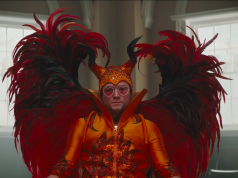Danish director Lars von Trier attracted attention in 1995 when he began the “Dogme” movement of filmmaking, in which directors eschew special effects, camera tricks, musical scores and expensive film stock to create a more natural, back-to-basics movie.
He uses this style and provides numerous contrasts to it in his ambitious and flawed new “Dancer in the Dark.”
Dogma filmmaking almost inevitably leads to bleakness, at least in the way the film looks, if not in its actual content. Real life is not as prettified, and real people don’t look as glamorous, as they do in movies; Dogme takes that away.
“Dancer in the Dark” has a bleakness of tone, too, as well as physical appearance. Icelandic pop star Björk plays Selma, a European woman who has fled to America in 1964 to seek a better life for her son, Gene (Vladan Kostic), working at a factory to make ends meet.
Her secrets are that she is slowly going blind from a hereditary condition, and that she is covertly saving money for an operation — not for herself, but for Gene, whom she believes will suffer the same fate unless he has this operation near his 13th birthday.
She lives in a trailer on the property of wealthy couple Bill (David Morse) and Linda (Cara Seymour). Bill confides in Selma that he’s not actually wealthy anymore, and that he can’t bring himself to tell Linda. He learns of Selma’s secret money stash and, when he attempts to steal it from her, there are dire consequences.
It’s an almost operatic sequence of events as things get worse and worse for Selma, and Björk is surprisingly good at portraying the tragic figure. (French film legend Catherine Deneuve is also marvelous as her best friend, Kathy.)
What keeps Selma going is her love for American musicals. The rhythms of life — factory machines, trains, etc., — sound like music to her, and she imagines herself and others bursting into song and dance, just like in the movies, as a means of escapism. This is where “Dancer in the Dark” leaves the Dogme concepts its been using fairly strictly and goes the opposite direction: dozens of cameras on tripods capturing numerous singers and dancers in lush, colorful settings. Just as the fantasy musical numbers take Selma away from her increasingly dismal life, they take the film away from its bleak, naturalistic tendencies.
Hard-core defenders of the movie are able to justify nearly all of its flaws as being part of the theme — intentional, in other words. The movie often drags on too long, making it so the musical numbers are a welcome respite? Well, that’s how it is for Selma, too. The lyrics in the songs are stupid and amateurish? Of course they are: Selma’s making them up in her head as she goes along. Selma is at times almost senselessly heroic, using faulty reasoning to pass up opportunities to turn things around? What did you expect? This is a woman whose frequent musical fantasies have already demonstrated her tenuous grip on reality.
I can go along with some of this, to a point; however, I have difficulty believing von Trier made his movie 30 minutes too long on purpose, or that a writer whose native tongue was English couldn’t have come up with better lyrics. (Von Trier scripted, too.)
Nonetheless, he uses his concept very well. By the time we’ve reached the haunting conclusion, Selma’s situation has become so oppressively bleak that even with all her powers of imagination, the best she can do for a song is to count from one to 107. And at the VERY end, she’s no longer singing in fantasy; she’s doing it for real, out loud, in front of others, her last-ditch attempt to escape from life.
“Dancer in the Dark” is not a typical movie in any sense, and it’s certainly not an average musical. There are only six or seven songs in the entire 140-minute film, and the first one doesn’t appear until 40 minutes in. Furthermore, no one just bursts into song like they do in shows: Except for the one just mentioned, all the songs occur only in Selma’s head; that’s the point, after all, that she imagines her life as a musical in order to avoid the nightmare it really is.
The Dogme stuff sometimes lends theater-style realism — like in Bill and Selma’s scene of confessing their secrets to each other — but more often it distracts. (Ironically, we’re so used to conventional filmmaking that when we see something that is, technically, more realistic, it seems fake to us.) Letting the actors ad-lib a lot of their dialogue doesn’t help any, as it often sounds TOO improvised: not like normal conversation, but like two actors trying really hard to improvise because they know the camera is rolling.
If you allow yourself to become enveloped in the whole thing, you’re liable to be emotionally affected by it, as the performances are generally strong. Still, its melodrama and over-length detract, almost negating its point for originality.
B (2 hrs., 21 min.; )





